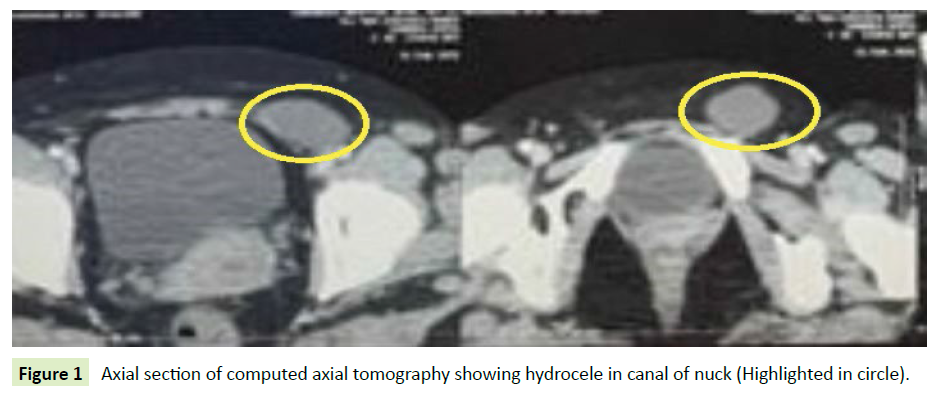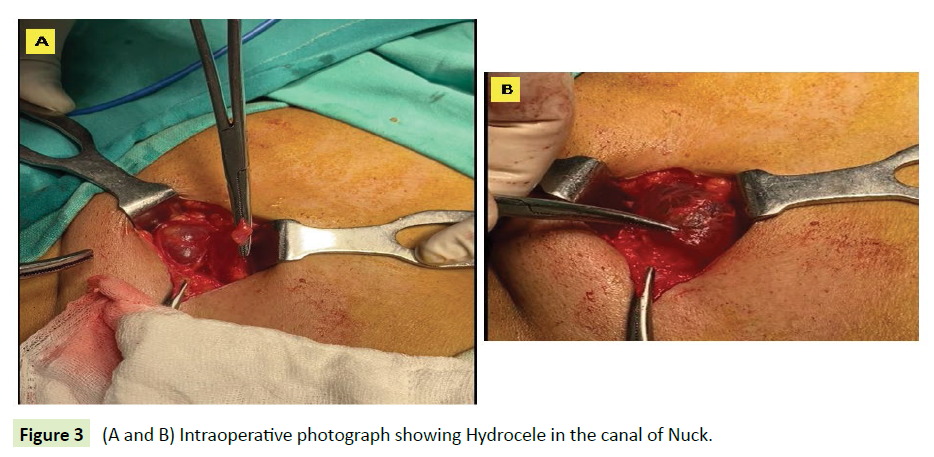Aditi Jain*, Sangeeta Jain and Rahul Gupta
Department of Obstetrics and Gynaecology, Jain Hospital, New Delhi, India
- *Corresponding Author:
- Aditi Jain
Department of Obstetrics and Gynaecology
Jain Hospital, New Delhi-110092, India
Tel: +91-9971703341
E-mail: aditijain1205@gmail.com
Received Date: May 25, 2021; Accepted Date: June 17, 2021; Published Date: June 25, 2021
Citation:Jain A, Jain S, Gupta R (2021) An Unusual Inguinal Swelling: Large Hydrocele of Canal of Nuck. Gynecol Obstet Case Rep Vol.7 No.6:141.
Keywords
Canal of Nuck; Female hydrocele; Inguinolabial swelling; Patent
processus vaginalis
Introduction
The hydrocele of the canal of Nuck is an unusual entity that can
present as an inguinal swelling in a female. Hydrocele of the canal
of Nuck is analogous to encysted hydrocele of the spermatic cord
in men [1]. Often called as ‘Female Hydrocele’, it was first studied
by Dutch anatomist Anton Nuck, who named the processus
vaginalis peritonei in the inguinal canal as ‘Canal of Nuck’. This
evagination of the parietal peritoneum accompanies the round
ligament into the labium during embryogenesis. This processus
gets obliterated normally by one year of life [2]. However, patent
processus vaginalis may lead to inguinal hernia or hydrocele.
Though a preoperative diagnosis is difficult to ascertain, operative
evaluation often confirms this entity. Here, we present a case of
a 36 year old female who presented with hydrocele of Canal of
Nuck and managed successfully with surgery.
Case Report
A 36-year-old lady presented with swelling in left inguinolabial
swelling. The patient had no significant history except the Lower
Segment Caesarian Section (LSCS) 4 years ago. On examination,
there was a soft oval mass extending from the left inguinal region
to the labia majora. There were no signs of inflammation. The
mass increased on standing position but did not disappear on
lying down. An ultrasonography and Computed Tomography
(CT) scan was done for further evaluation. CT scan revealed well
defined lobular homogenous fluid-filled cyst approximately 10
cm × 3 cm seen in the left inguinal region extending up to the left
labia. Operative findings included a cystic mass in the left inguinal
canal extending into the ipsilateral labia majora with clear fluid in the cyst. The swelling was confirmed to be the encysted hydrocele
with no evidence of an associated inguinal hernia. The cyst was
adherent to the round ligament but could be dissected from
the surrounding tissues and high ligation of the canal was done
after excision of the cyst. The fluid cytology was unremarkable
and histopathology of the excised cyst wall revealed histiocytic
infiltration and inflammatory granulation tissue with no evidence
of malignancy. This affirmed the diagnosis of hydrocele of the
canal of Nuck and the postoperative course was uneventful.
The patient had completed three months of follow-up with no
evidence of recurrence or any other complication.
Discussion
Canal of Nuck is an extension of the peritoneal fold to the labia
majora through the inguinal canal. Failure of obliteration of this
peritoneal fold might lead to fluid collection or herniation. This
sac might contain peritoneal fluid, omental fat, bowel loop, or
even rarely ovary or fallopian tube. A hydrocele of the canal of
Nuck is a collection of fluid within processus vaginalis [3].
Clinically, the hydrocele of the canal of Nuck can appear as
painless or painful, reducible or irreducible swelling in the inguinal
region. As per a review by Prodromidou et al. [1] the mean age
of presentation is 35 years with 80% patients in the reproductive
age group. Right side hydrocele was more common as compared
to left. Our patient belonged to the reproductive age group but
had a left-sided hydrocele.
Though a preoperative diagnosis is difficult to ascertain,
preoperative imaging including ultrasonography and CT scan
are the most common modalities, which can point towards the
diagnosis. Ultrasonography, which is often the first modality of
imaging, might show a comma-shaped lesion with its tail towards
the inguinal canal, calling it a 'cyst within a cyst' appearance
[4]. However, ultrasonography is rarely conclusive and CT scan
or Magnetic Resonance Imaging provides a higher resolution and reproducibility. Kono et al. [2] showed the role of MR
hydrography in the diagnosis and preoperative planning of this
female hydrocele. In our patient, a CT scan showed features
suggestive of the canal of Nuck cyst (Figures 1-3).
Figure 1: Axial section of computed axial tomography showing hydrocele in canal of nuck (Highlighted in circle).
Figure 2: Sagital section of computed axial tomography showing hydrocele in canal of nuck (Highlighted in circle).
Figure 3: (A and B) Intraoperative photograph showing Hydrocele in the canal of Nuck.
Surgical treatment involving excision of cyst and repair of the
defect remains the standard of care, the preservation or ligation
of round ligament is variable. Open excision has been more
popular, however, few authors have reported laparoscopic approach as well [1]. The patent canal of Nuck can often present
in an emergency. Scott et al. [5] reported a case of hydrocele
of canal of Nuck with features of peritonitis. The patient was
managed with emergency surgical exploration. In another case
by Noguchi et al. [6], the canal of Nuck cyst was complicated with
the development of ectopic pregnancy which was managed with
laparotomy. Rarely, the canal of Nuck has been reported to be
associated with endometriosis. Okoshi et al. [7] described a rare
case of isolated endometriosis in the canal of Nuck in a patient
with prior history of intrapelvic endometriosis. The patient was
managed with open surgical excision and immunohistochemical
staining of calretinin and podoplanin confirmed the diagnosis.
The prognosis of the female hydrocele is good and complete
excision rarely leads to recurrence. Prodromidou et al. [1] in a
review of 16 cases showed no recurrence of the lesion in a followup
period ranging between 2 months-24 months.
Conclusion
The hydrocele of the canal of Nuck is a rare and unusual entity and
with increasing awareness in both surgeons and gynecologists,
this differential diagnosis should be kept in mind during the
evaluation of inguinolabial lump. The clinical diagnosis is difficult
to ascertain and surgical management remains the definitive
diagnostic as well as the therapeutic procedure.
Conflicts of Interest
None to mention.
Patient Consent
Informed consent was taken from the patient.
References
- Prodromidou A, Paspala A, Schizas D, Spartalis E, Nastos C, et al.
(2020) Cyst of the canal of nuck in adult females: A case report and
systematic review. Biomed Rep 12: 333-338.
- Kono R, Terasaki H, Murakami N, Tanaka M, Takeda J, et al. (2015)
Hydrocele of the canal of Nuck: a case report with magnetic
resonance hydrography findings. Surg Case Rep 1: 86-92.
- Block RE (1975) Hydrocele of the canal of nuck: A report of five cases.
Obstet Gynecol 45: 464-466.
- Jagdale R, Agrawal S, Chhabra S, Jewan SY (2012) Hydrocele of the canal of nuck: Value of radiological diagnosis. J Radiol Case Rep 6:18-22.
- Scott M, Helmy AH (2020) Rare encounter: Hydrocoele of canal of
Nuck in a Scottish rural hospital during the COVID-19 pandemic. BMJ
Case Rep 13: e237169.
- Noguchi D, Matsumoto N, Kamata S, Kaneko K (2014) Ectopic
pregnancy developing in a cyst of the canal of Nuck. Obstet Gynecol
123: 472-476.
- Okoshi K, Mizumoto M, Kinoshita K (2017) Endometriosis-associated
hydrocele of the canal of nuck with immuno-histochemical
confirmation: A case report. J Med Case Reports 11: 354-359.




